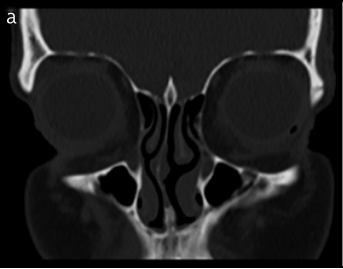Objective: Maxillary growth is highly influenced by environmental factors. In some cases, facial growth in the horizontal plane is compromised in favor of vertical growth. When a patient experiences excessive vertical facial growth, the frontal bone remains stable, whereas the maxilla and ethmoid gradually drop. We hypothesized that the lowering of the ethmoid could explain the gap between the ethmoidal notch and lamina cribosa and therefore be a cause of the differences in olfactory fossa depth.
Methods: We selected 201 consecutive CT sinonasal scans and analyzed 3D-reconstruction planes. Four indicators of excessive vertical facial growth were measured (saddle angle, sella-nasion-anterior maxilla [SNA] angle, indicator line, and facial index).
Results: The mean olfactory fossa depth was 5.63 mm. There was a statistically significant association (p<0.001) between olfactory fossa depth and the four indicators of excessive vertical facial growth combined. There was also an association between olfactory fossa depth and each indicator: facial index (p<0.001), saddle angle (p<0.001), SNA angle (p<0.001), and indicator line (p=0.001).
Conclusion: We found a statistically significant relationship between the four indicators of excessive vertical facial growth and the depth of the olfactory fossa. These results support our hypothesis, which states that the middle face drops in vertical facial growth, creating a gap in the olfactory fossa. Our results compel otolaryngologists to thoroughly check the depth of the olfactory fossa when treating patients with excess vertical facial growth scheduled for endoscopic sinus surgery.
Cite this article as: Calvo-Henriquez C, Ruano-Ravina A, Martinez-Capoccioni G, et al. Is an increase in the depth of the olfactory fossa caused by excessive vertical facial growth? A radiological study. B-ENT 2020; 16(1): 25-30.



.png)

